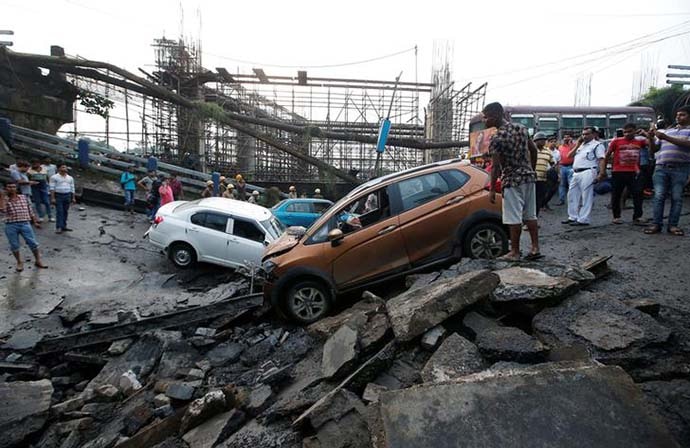From bridge collapse to market fire: Why Mamata Banerjee can't go beyond cosmetic changes

It took 30 hours to douse the Bagree Market fire, but it will take even lesser time to forget the lessons learnt.
Two major incidents, a bridge collapse and a fire at a wholesale market — both within a fortnight — have once again established how casual, to the point of being apathetic, the government is to public safety.
The apathy has nothing to do with ignorance; rather it is a consciously cultivated custom, coming down the ages through parties and politicians in power to protect their vote-bank in the race to survival.
The cause of a fire at Bagree market, a wholesale market in central Kolkata, located within a stone’s throw away from the police headquarters, was a hawking shack in front, which stored bottles of perfumes.

An eyewitness said that the perfume bottles were exploding like fire crackers and he, mistaking it to be the revelry of a Ganesh immersion ceremony, came out to see the shack in flames. Before people could be rushed to control the fire, the blaze caught the bales of cable wires stretched on the pavement and the overhanging wires, engulfing the whole building.
It took 30 hours to douse the fire, but it will take even lesser time to forget the lessons learnt.
A major fire which broke out at the Nandaram Market in 2008 and went on raging for 100 hours, in the last leg of the Left Front rule, brought in a set of stringent rules and regulations concerning fire safety.
Nobody knows whether there was ebb in mushrooming of commercial units after that, but in a larger and wider context, there was one visible outcome for everyone to see: the Left lost these pockets and eventually its citadel in Bengal.
According to a 75-year-old resident in Bagree, the market built in 1950s had a sprawling entrance.
With time and obviously with the votebank pandering exercise, the Canning Street, where the market stood, was taken up by hawkers, small shops and vendors with wicker baskets.
“Not any space, even as small as a toehold, in this area goes to waste. Even for a wicker basket, the seller has to pay some thousands as haafta to the local dada,” said Anisuzzaman, a local.
There was only a ribbon of a space for the fire engines to move and add to that the overhanging mesh of spaghetti wiring; fire fighting was made absolutely impossible.
Even the crores of money spent on hydraulic ladders for controlling fire on high-rises could not be used because the overhead wires could not be snapped.
Who could be held for the aerial acquisition?
When every inch of such a commercial spot reaps gold, a mutual symbiotic give-and-take exchange that benefits all for a short term, who cares for future consequences or an eventuality of a tragedy? And public memory is too short. The six-storey Bagree market has been reduced to heaps of mangled metals and ashes.
A thousand shops, cubicles, call what you may, have been charred beyond recognition. Losses, so far estimated at Rs 200 crore, are mounting.
The chief minister has formed an 11-member committee of ministers to take a call — more committees, more laws and steep penalty for aberration.
Ministers are making daily rounds, assuring victims that they will be amply compensated. Never mind that they, the government and the various political representatives, flouted fire safety rules.

And if the Majherhat bridge, built in 1950, collapsed and 21 other bridges in the city are waiting to follow suit, the government has done its bit by forewarning: take the bridges at your own risk.
Some of these bridges came up during colonial times and many in the Congress and Left regime.
So, the current government, in a way has washed its hands off any parental or major responsibility.
And as far as repair and maintenance is concerned, the government has come up with alibis to wriggle out of any onus.
If the condition of the bridges is deteriorating, it’s partly because of the unauthorised settlement and hawking zones underneath most of the flyovers.
The Sealdah flyover, which is one such bridge that requires immediate attention, has an entire market under it. The market is not only a source of livelihood for lakhs of people, it is a night shelter to the population which migrates from neighbouring states and fills the political rallies and ballot boxes.
West Bengal chief minister has pleaded helplessness about clearing the unauthorised occupants, even though she has spelt provision for relocation and compensation.
Obviously, there’s a humanitarian side and the “Ma-Maati-Manush” government cannot falter on its basic tenets.
So, if the bridges develop cracks or potholes and give a bumpy ride, the best and easiest option is to brush everything under the carpet: cement the cracks, fill up the holes with layers and layers of bitumen, notwithstanding that such overloading and cosmetic changes are actually ruining its longevity, and above everything else, awash the grime, the filth, everything that is apparently eye-sore with the city’s dress code —blue and white colours.
And the PWD department tried doing so in case of Majherhat Bridge, when the finance was taking time to release fund for maintenance.
(Courtesy of Mail Today)

